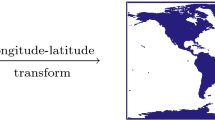Abstract
The representation of three-dimensional star-shaped objects by the double Fourier series (DFS) coefficients of their boundary function is considered. An analogue of the convolution theorem for a DFS on a sphere is developed. It is then used to calculate the moments of an object directly from the DFS coefficients, without an intermediate reconstruction step. The complexity of computing the moments from the DFS coefficients is O(N 2 log N), where N is the maximum order of coefficients retained in the expansion, while the complexity of computing the moments from the spherical harmonic representation is O(N 2 log 2 N). It is shown that under sufficient conditions, the moments and surface area corresponding to the truncated DFS converge to the true moments and area of an object. A new kind of DFS—the double Fourier sine series—is proposed which has better convergence properties than the previously used kinds and spherical harmonics in the case of objects with a sharp point above the pole of the spherical domain.
Similar content being viewed by others
References
Baxansky A, Kiryati N (2007) Calculating geometric properties of three-dimensional objects from the spherical harmonic representation. Pattern Recognit 40: 756–770
Boer GJ, Steinberg L (1975) Fourier series on spheres. Atmosphere 13: 180–191
Brechbühler Ch, Gerig G, Kübler O (1995) Parameterization of closed surfaces for 3-D shape description. Comput Vis Image Underst 61: 154–170
Cheong H-B (2000) Double Fourier series on a sphere: applications to elliptic and vorticity equations. J Comput Phys 157: 327–349
Cheong H-B (2000) Application of double Fourier series to the shallow-water equations on a sphere. J Comput Phys 165: 261–287
Cohen-Tannoudji C, Diu B, Lalo F (1977) Quantum mechanics. Wiley, New York
Driscoll JR, Healy DM Jr (1994) Computing Fourier transforms and convolutions on the 2-sphere. Adv Appl Math 15: 202–250
Ertürk S, Dennis TJ (1997) 3D model representation using spherical harmonics. Electron Lett 33: 951–952
Healy D Jr, Rockmore D, Kostelec P, Moore S (2003) FFTs for the 2-sphere—improvements and variations. J Fourier Anal Appl 9: 341–385
Li J (2002) 3D shape modeling: registration, segmentation, and reconstruction. PhD thesis, Dept. of EECS, Univ. of Michigan, Ann Arbor, 48109-2122
Li J, Hero AO (2004) A fast spectral method for active 3D shape reconstruction. J Math Imaging Vis 20: 73–87
Orszag SA (1974) Fourier series on spheres. Mon Weather Rev 102: 56–75
Saupe D, Vranic DV (2001) 3D model retrieval with spherical harmonics and moments. Proc DAGM. Munich, Germany, pp 392–397
Weinberger HF (1965) A first course in partial differential equations. Wiley, New York
Yee SYK (1980) Studies on Fourier series on spheres. Mon Weather Rev 108: 676–678
Yee SYK (1981) Solution of Poisson’s equation on a sphere by truncated double Fourier series. Mon Weather Rev 109: 501–505
Author information
Authors and Affiliations
Corresponding author
Additional information
Communicated by D. Saupe.
Rights and permissions
About this article
Cite this article
Baxansky, A., Kiryati, N. Use of a double Fourier series for three-dimensional shape representation. Computing 88, 173–191 (2010). https://doi.org/10.1007/s00607-010-0092-1
Received:
Accepted:
Published:
Issue Date:
DOI: https://doi.org/10.1007/s00607-010-0092-1




